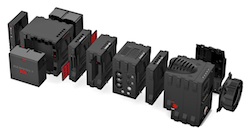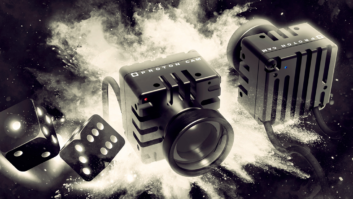
The tiny Ikonoskop A-Cam dII digital film camera is finally ready to ship, two years after being announced at IBC2008.
It can record uncompressed HD raw from its single 2/3-inch 1920×1080 (250-300 ISO) CCD sensor to a swappable 160GB card. It uses the Adobe Cinema DNG format that can be edited by Adobe or (soon) Avid software, and is also compatible with Iridas grading software, CineForm and MXF4Mac conversions tools, and will soon be supported by Da Vinci. As other camera manufacturers are adopting Cinema DNG (such as Indiecam with its 3D camera), other software should also support the format.
The camera uses a standard Sony battery and can be fitted with PL-mount, C-mount, Leica M or IMS lenses. “16mm lenses are ideal, because they are available at very low cost,” said founder, Daniel Jonsäter (pictured). The A-Cam dII will cost €6,950, plus between €550 to €750 for a lens mount. The memory cards, which were developed by Ikonoskop because it couldn’t find one that was fast enough elsewhere (with a writing speed of 240MB per second), will cost €950. Each frame takes up 3.5Mb and a card can hold 34 minutes at 25fps.
There will also be a memory card reader (which was shown in prototype), which will display rushes and has a USB 2.0 connection for loading into a computer. It takes about two hours to offload 30 minutes of video, so for serious shooting users would need at least four cards.
It can shoot at up to 30fps, fully variable, and its first use was for the title sequence of a Swedish feature film – the footage is viewable on its website, where there is also some uncompressed video (as well as ProRes and H.264) that can be downloaded to test the workflow. Development was delayed because “2009 was a really rough year financially. We lost all of our funding, so had to put down all development for some months,” explained Jonsäter. Fortunately, “all problems are now solved,” and it has more than 50 orders, with down payments – mostly from Sweden and the Netherlands. The first cameras should ship by the end of October.
The funding problems meant that development also had to stop on its 3D camcorder, although it will have a software option for the standard dII to sync two cameras to line level (a 200th of a frame) in master/slave mode. Jonsäter hopes to resume work on the integrated 3D camcorder, “but it’s not a priority. It will probably be IBC next year.”
In the meantime, Ikonoskop is also developing a refined version of its A-Cam SP16 compact 16mm film camera (often used as a crash camera on movies). It will have higher frame rates, improved electronics, and bug fixes, and should be available during 2011.







